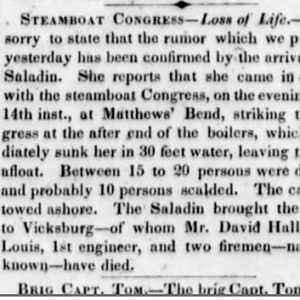calsfoundation@cals.org
Collision of Congress and Saladin
The steam packet Saladin collided with the steamboat Congress on the evening of February 14, 1846, near Islands 86 and 87 in the Mississippi River at Kentucky Bend off Chicot County, sinking the Congress and killing as many as thirty passengers and crew.
The Saladin, a sidewheel packet built in Louisville, Kentucky, by Thomas C. Coleman and John Coleman in 1846, was steaming toward New Orleans, Louisiana, as the steamboat Congress was heading upriver with a load of dry goods and both cabin and deck passengers. The Saladin, having stopped at the landing of the William H. Pope plantation, reentered the river channel at about 7:00 p.m. on the “cloudy and very dark” night. Spying the Saladin when it was about two miles away, the pilot of the Congress steered the boat toward the shorelines of Islands 86 and 87 in order to give the packet free passage through the Kentucky Bend.
However, according to J. B. Weaver, the clerk of the Congress, “instead of the Saladin keeping the bend, she came heading across the river to the Congress.” The latter steamboat immediately stopped and put its engines in reverse, but the Saladin slammed into the Congress amidship on its starboard side, breaking a boiler’s steam pipe and sending scalding steam and water through the vessel, badly scalding engineer David Hall and injuring at least fourteen other passengers and crew members. Weaver said at least fifteen people drowned.
The Congress’s hull sank almost immediately in thirty feet of water as the deck and cabins floated free. Captain Durrett of the Saladin at first tried to come aside the wreckage to remove the passengers and, failing that, to tie a line to it, but the Saladin ultimately steamed ahead to Lake Providence, Louisiana, to seek medical help while the remains of the Congress drifted downstream. The Saladin managed to nudge the wreck to shore there.
The Saladin brought twelve of the scalded passengers and crew to Vicksburg, Mississippi, where engineer Hall and two crew members died; two others were taken to New Orleans, where they had friends to care for them. Varying contemporary accounts reported up to twenty passengers and crew of the Congress drowned and ten dead from being scalded.
The Saladin would continue plying the waters of the Ohio and Mississippi Rivers until 1851, when it was lost after hitting a snag at Thebes, Illinois.
The sinking of the Congress reflected the dangers of travel in the waters around Arkansas in the nineteenth century, when steamboat collisions also claimed the Gulnare in 1844, the Cote Joyeuse in 1847, and the Niagara in 1865.
For additional information:
“Another Terrible Disaster—Steamer Congress Sunk.” Jacksonville Republican (Alabama), March 18, 1846, p. 1.
“Card.” Nashville Tennessean, March 11, 1846, p. 2.
“Dreadful Steamboat Accident.” Baltimore Sun, February 27, 1846, p. 4.
“The Loss of the Congress.” Baltimore Sun, February 28, 1846, p. 4.
“River Intelligence.” Pittsburg Gazette, March 3, 1846, p. 3.
“Steamboat Congress—Loss of Life.” Daily Delta (New Orleans), February 19, 1846, p. 2.
Way, Frederick, Jr. Way’s Packet Directory. Athens: Ohio University Press, 1983, p. 414.
Mark K. Christ
Central Arkansas Library System
 Louisiana Purchase through Early Statehood, 1803 through 1860
Louisiana Purchase through Early Statehood, 1803 through 1860 Transportation
Transportation Congress and Saladin, Collision of
Congress and Saladin, Collision of 



Comments
No comments on this entry yet.